Attachment Theory and Homelessness: Psychological Perspectives
VerifiedAdded on 2022/12/29
|17
|5277
|3
Essay
AI Summary
This essay delves into the application of attachment theory to explain the situation of homeless individuals, exploring the relationship between attachment patterns and the mental health of this population. It begins by defining attachment theory, discussing its background, and outlining key concepts such as secure and insecure attachment styles in both infants and adults. The essay examines related theories and the contributions of Bowlby and Ainsworth, including the 'Strange Situation' experiment. It then explores the connection between attachment theory and homelessness, discussing how early attachment experiences can influence the likelihood of homelessness and the psychological challenges faced by homeless individuals. The essay also touches upon therapeutic relationships and the developmental needs of homeless people, highlighting how understanding attachment can inform effective interventions and support their emotional well-being.
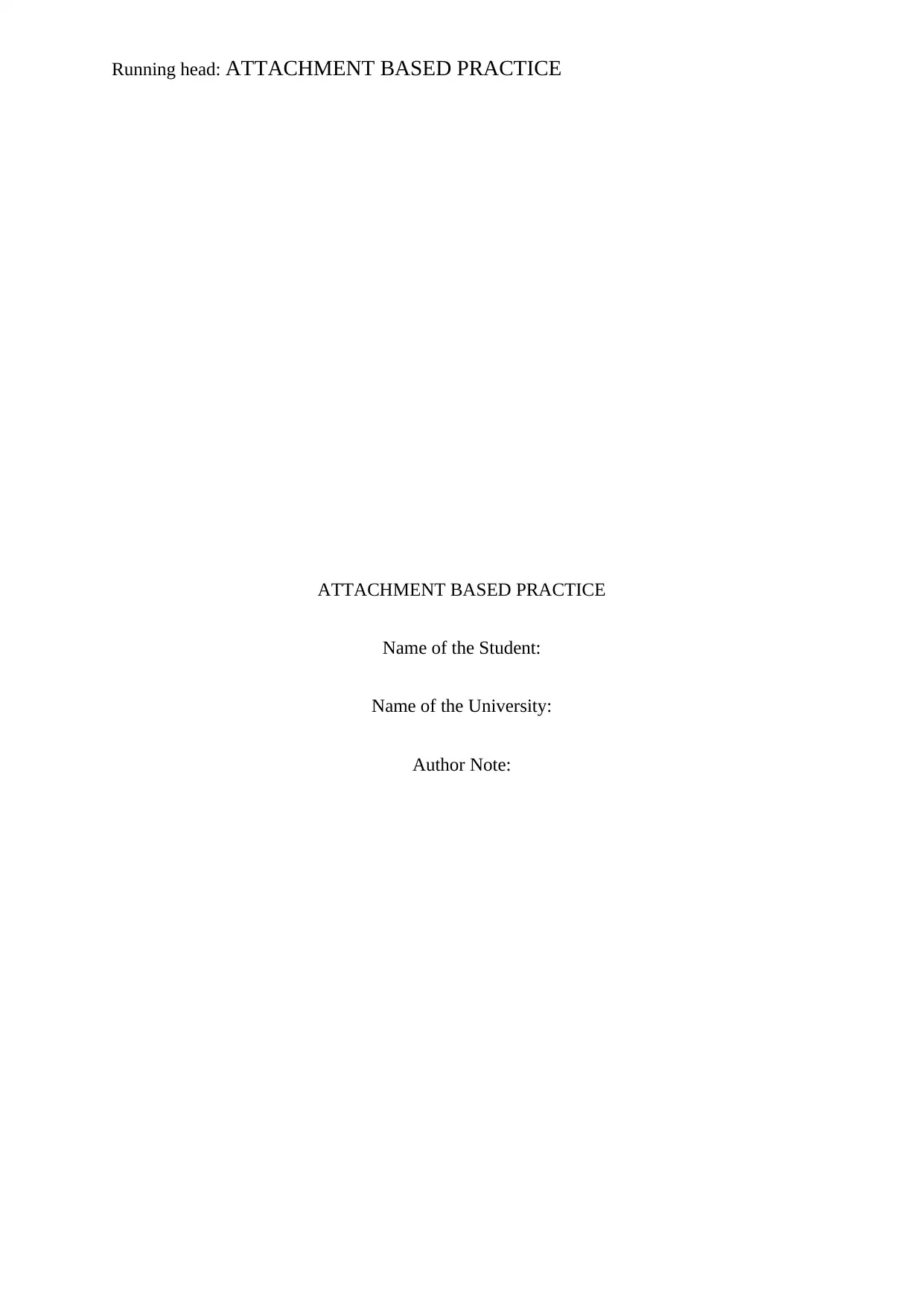
Running head: ATTACHMENT BASED PRACTICE
ATTACHMENT BASED PRACTICE
Name of the Student:
Name of the University:
Author Note:
ATTACHMENT BASED PRACTICE
Name of the Student:
Name of the University:
Author Note:
Paraphrase This Document
Need a fresh take? Get an instant paraphrase of this document with our AI Paraphraser
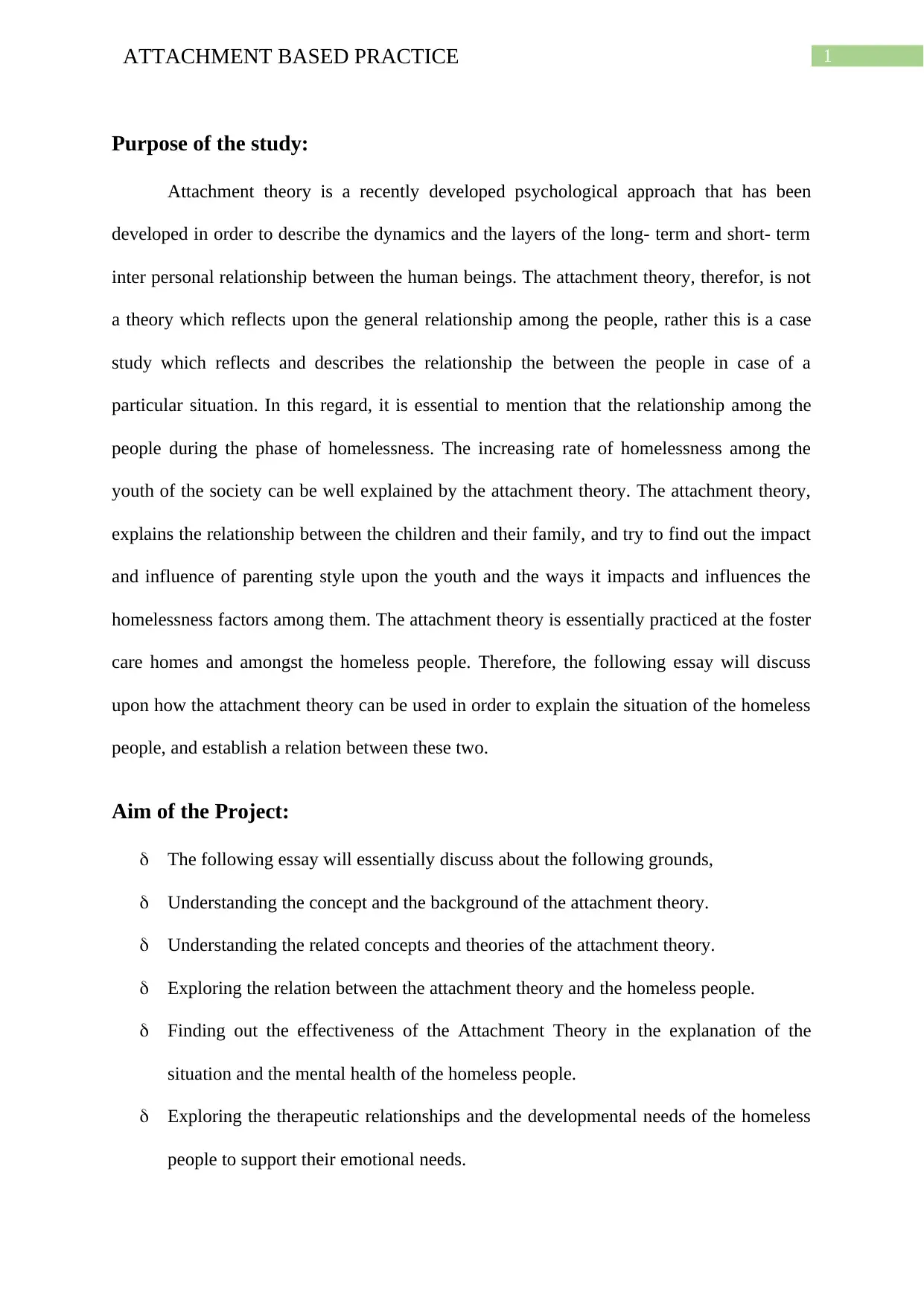
1ATTACHMENT BASED PRACTICE
Purpose of the study:
Attachment theory is a recently developed psychological approach that has been
developed in order to describe the dynamics and the layers of the long- term and short- term
inter personal relationship between the human beings. The attachment theory, therefor, is not
a theory which reflects upon the general relationship among the people, rather this is a case
study which reflects and describes the relationship the between the people in case of a
particular situation. In this regard, it is essential to mention that the relationship among the
people during the phase of homelessness. The increasing rate of homelessness among the
youth of the society can be well explained by the attachment theory. The attachment theory,
explains the relationship between the children and their family, and try to find out the impact
and influence of parenting style upon the youth and the ways it impacts and influences the
homelessness factors among them. The attachment theory is essentially practiced at the foster
care homes and amongst the homeless people. Therefore, the following essay will discuss
upon how the attachment theory can be used in order to explain the situation of the homeless
people, and establish a relation between these two.
Aim of the Project:
The following essay will essentially discuss about the following grounds,
Understanding the concept and the background of the attachment theory.
Understanding the related concepts and theories of the attachment theory.
Exploring the relation between the attachment theory and the homeless people.
Finding out the effectiveness of the Attachment Theory in the explanation of the
situation and the mental health of the homeless people.
Exploring the therapeutic relationships and the developmental needs of the homeless
people to support their emotional needs.
Purpose of the study:
Attachment theory is a recently developed psychological approach that has been
developed in order to describe the dynamics and the layers of the long- term and short- term
inter personal relationship between the human beings. The attachment theory, therefor, is not
a theory which reflects upon the general relationship among the people, rather this is a case
study which reflects and describes the relationship the between the people in case of a
particular situation. In this regard, it is essential to mention that the relationship among the
people during the phase of homelessness. The increasing rate of homelessness among the
youth of the society can be well explained by the attachment theory. The attachment theory,
explains the relationship between the children and their family, and try to find out the impact
and influence of parenting style upon the youth and the ways it impacts and influences the
homelessness factors among them. The attachment theory is essentially practiced at the foster
care homes and amongst the homeless people. Therefore, the following essay will discuss
upon how the attachment theory can be used in order to explain the situation of the homeless
people, and establish a relation between these two.
Aim of the Project:
The following essay will essentially discuss about the following grounds,
Understanding the concept and the background of the attachment theory.
Understanding the related concepts and theories of the attachment theory.
Exploring the relation between the attachment theory and the homeless people.
Finding out the effectiveness of the Attachment Theory in the explanation of the
situation and the mental health of the homeless people.
Exploring the therapeutic relationships and the developmental needs of the homeless
people to support their emotional needs.
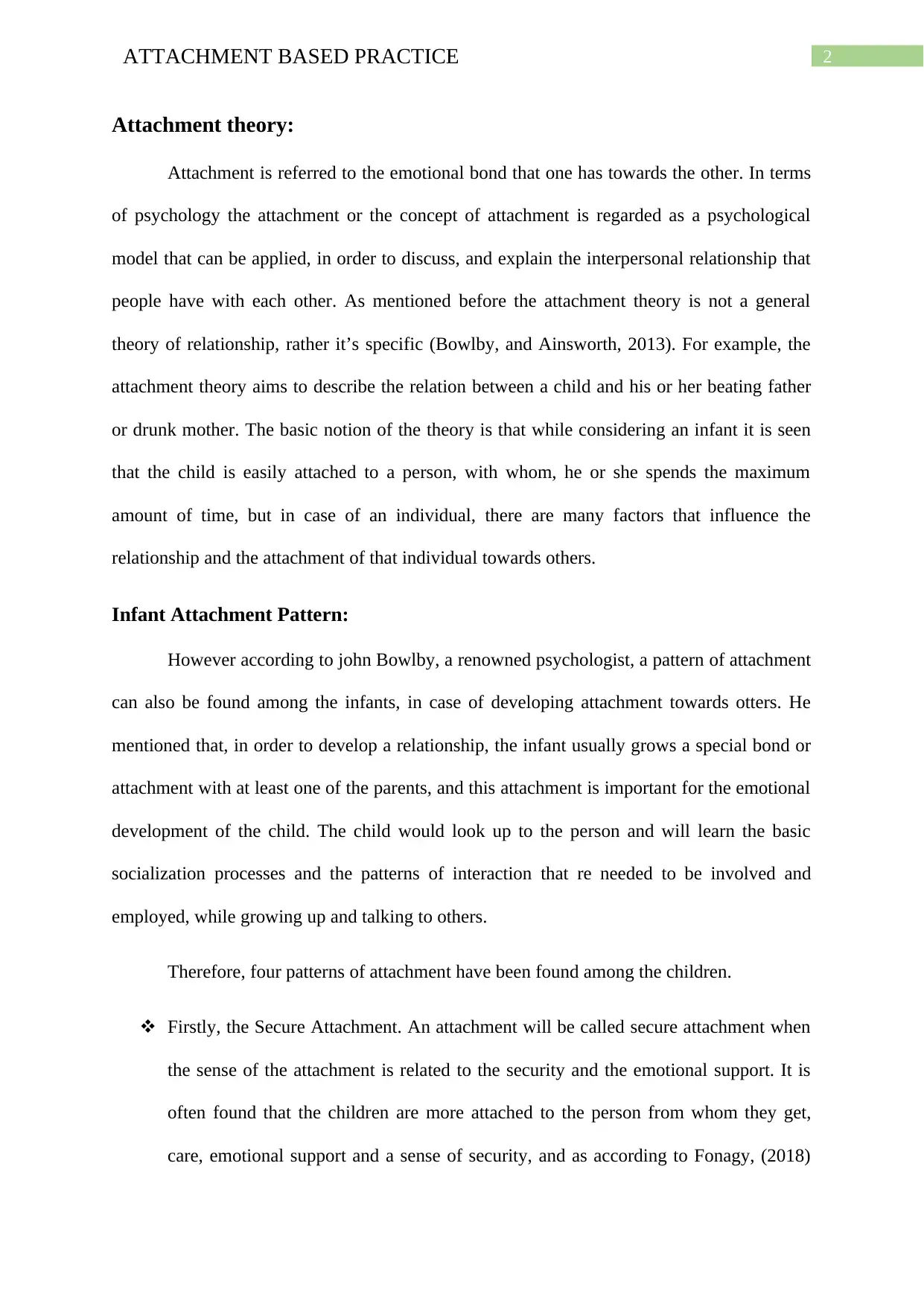
2ATTACHMENT BASED PRACTICE
Attachment theory:
Attachment is referred to the emotional bond that one has towards the other. In terms
of psychology the attachment or the concept of attachment is regarded as a psychological
model that can be applied, in order to discuss, and explain the interpersonal relationship that
people have with each other. As mentioned before the attachment theory is not a general
theory of relationship, rather it’s specific (Bowlby, and Ainsworth, 2013). For example, the
attachment theory aims to describe the relation between a child and his or her beating father
or drunk mother. The basic notion of the theory is that while considering an infant it is seen
that the child is easily attached to a person, with whom, he or she spends the maximum
amount of time, but in case of an individual, there are many factors that influence the
relationship and the attachment of that individual towards others.
Infant Attachment Pattern:
However according to john Bowlby, a renowned psychologist, a pattern of attachment
can also be found among the infants, in case of developing attachment towards otters. He
mentioned that, in order to develop a relationship, the infant usually grows a special bond or
attachment with at least one of the parents, and this attachment is important for the emotional
development of the child. The child would look up to the person and will learn the basic
socialization processes and the patterns of interaction that re needed to be involved and
employed, while growing up and talking to others.
Therefore, four patterns of attachment have been found among the children.
Firstly, the Secure Attachment. An attachment will be called secure attachment when
the sense of the attachment is related to the security and the emotional support. It is
often found that the children are more attached to the person from whom they get,
care, emotional support and a sense of security, and as according to Fonagy, (2018)
Attachment theory:
Attachment is referred to the emotional bond that one has towards the other. In terms
of psychology the attachment or the concept of attachment is regarded as a psychological
model that can be applied, in order to discuss, and explain the interpersonal relationship that
people have with each other. As mentioned before the attachment theory is not a general
theory of relationship, rather it’s specific (Bowlby, and Ainsworth, 2013). For example, the
attachment theory aims to describe the relation between a child and his or her beating father
or drunk mother. The basic notion of the theory is that while considering an infant it is seen
that the child is easily attached to a person, with whom, he or she spends the maximum
amount of time, but in case of an individual, there are many factors that influence the
relationship and the attachment of that individual towards others.
Infant Attachment Pattern:
However according to john Bowlby, a renowned psychologist, a pattern of attachment
can also be found among the infants, in case of developing attachment towards otters. He
mentioned that, in order to develop a relationship, the infant usually grows a special bond or
attachment with at least one of the parents, and this attachment is important for the emotional
development of the child. The child would look up to the person and will learn the basic
socialization processes and the patterns of interaction that re needed to be involved and
employed, while growing up and talking to others.
Therefore, four patterns of attachment have been found among the children.
Firstly, the Secure Attachment. An attachment will be called secure attachment when
the sense of the attachment is related to the security and the emotional support. It is
often found that the children are more attached to the person from whom they get,
care, emotional support and a sense of security, and as according to Fonagy, (2018)
⊘ This is a preview!⊘
Do you want full access?
Subscribe today to unlock all pages.

Trusted by 1+ million students worldwide
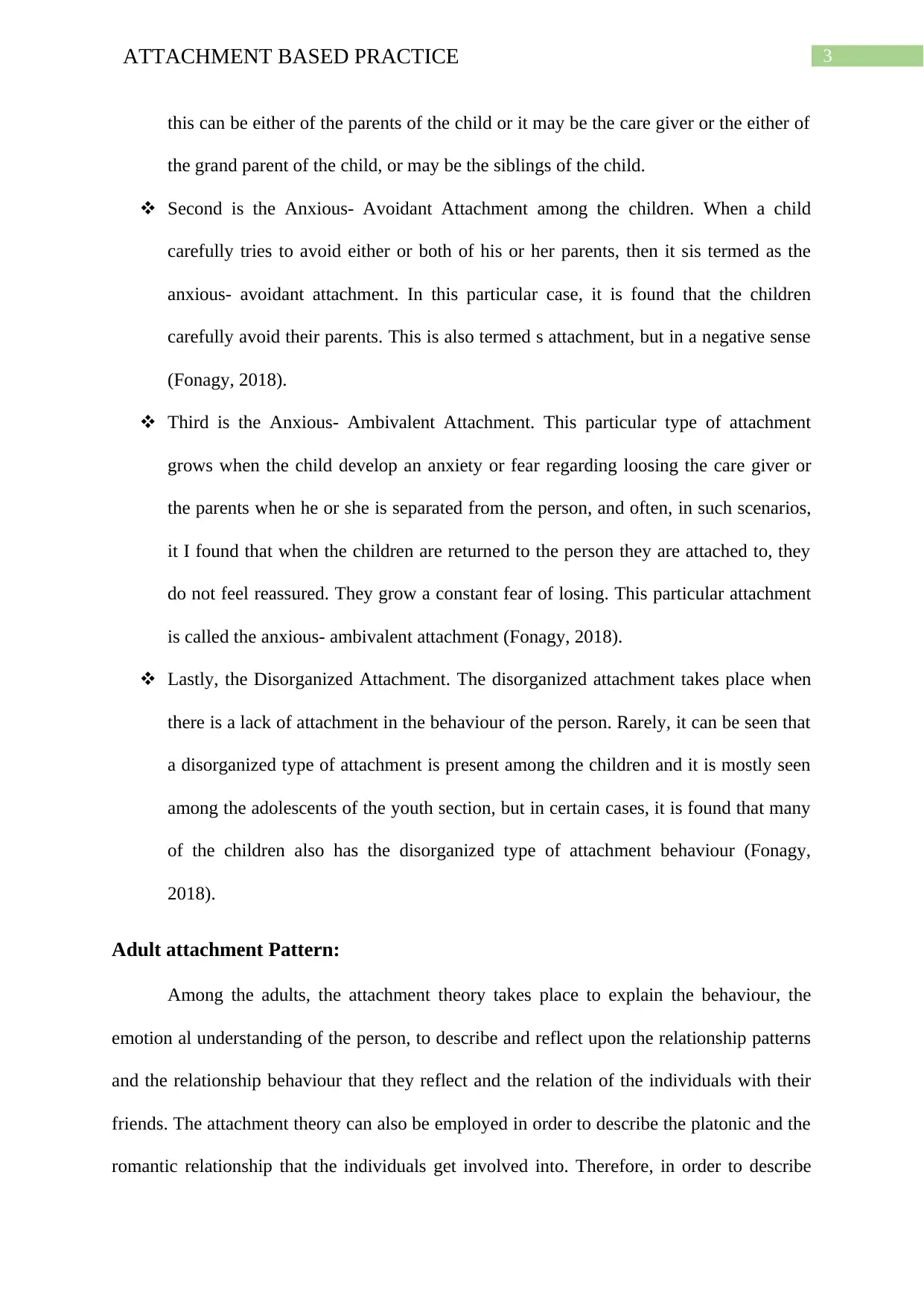
3ATTACHMENT BASED PRACTICE
this can be either of the parents of the child or it may be the care giver or the either of
the grand parent of the child, or may be the siblings of the child.
Second is the Anxious- Avoidant Attachment among the children. When a child
carefully tries to avoid either or both of his or her parents, then it sis termed as the
anxious- avoidant attachment. In this particular case, it is found that the children
carefully avoid their parents. This is also termed s attachment, but in a negative sense
(Fonagy, 2018).
Third is the Anxious- Ambivalent Attachment. This particular type of attachment
grows when the child develop an anxiety or fear regarding loosing the care giver or
the parents when he or she is separated from the person, and often, in such scenarios,
it I found that when the children are returned to the person they are attached to, they
do not feel reassured. They grow a constant fear of losing. This particular attachment
is called the anxious- ambivalent attachment (Fonagy, 2018).
Lastly, the Disorganized Attachment. The disorganized attachment takes place when
there is a lack of attachment in the behaviour of the person. Rarely, it can be seen that
a disorganized type of attachment is present among the children and it is mostly seen
among the adolescents of the youth section, but in certain cases, it is found that many
of the children also has the disorganized type of attachment behaviour (Fonagy,
2018).
Adult attachment Pattern:
Among the adults, the attachment theory takes place to explain the behaviour, the
emotion al understanding of the person, to describe and reflect upon the relationship patterns
and the relationship behaviour that they reflect and the relation of the individuals with their
friends. The attachment theory can also be employed in order to describe the platonic and the
romantic relationship that the individuals get involved into. Therefore, in order to describe
this can be either of the parents of the child or it may be the care giver or the either of
the grand parent of the child, or may be the siblings of the child.
Second is the Anxious- Avoidant Attachment among the children. When a child
carefully tries to avoid either or both of his or her parents, then it sis termed as the
anxious- avoidant attachment. In this particular case, it is found that the children
carefully avoid their parents. This is also termed s attachment, but in a negative sense
(Fonagy, 2018).
Third is the Anxious- Ambivalent Attachment. This particular type of attachment
grows when the child develop an anxiety or fear regarding loosing the care giver or
the parents when he or she is separated from the person, and often, in such scenarios,
it I found that when the children are returned to the person they are attached to, they
do not feel reassured. They grow a constant fear of losing. This particular attachment
is called the anxious- ambivalent attachment (Fonagy, 2018).
Lastly, the Disorganized Attachment. The disorganized attachment takes place when
there is a lack of attachment in the behaviour of the person. Rarely, it can be seen that
a disorganized type of attachment is present among the children and it is mostly seen
among the adolescents of the youth section, but in certain cases, it is found that many
of the children also has the disorganized type of attachment behaviour (Fonagy,
2018).
Adult attachment Pattern:
Among the adults, the attachment theory takes place to explain the behaviour, the
emotion al understanding of the person, to describe and reflect upon the relationship patterns
and the relationship behaviour that they reflect and the relation of the individuals with their
friends. The attachment theory can also be employed in order to describe the platonic and the
romantic relationship that the individuals get involved into. Therefore, in order to describe
Paraphrase This Document
Need a fresh take? Get an instant paraphrase of this document with our AI Paraphraser
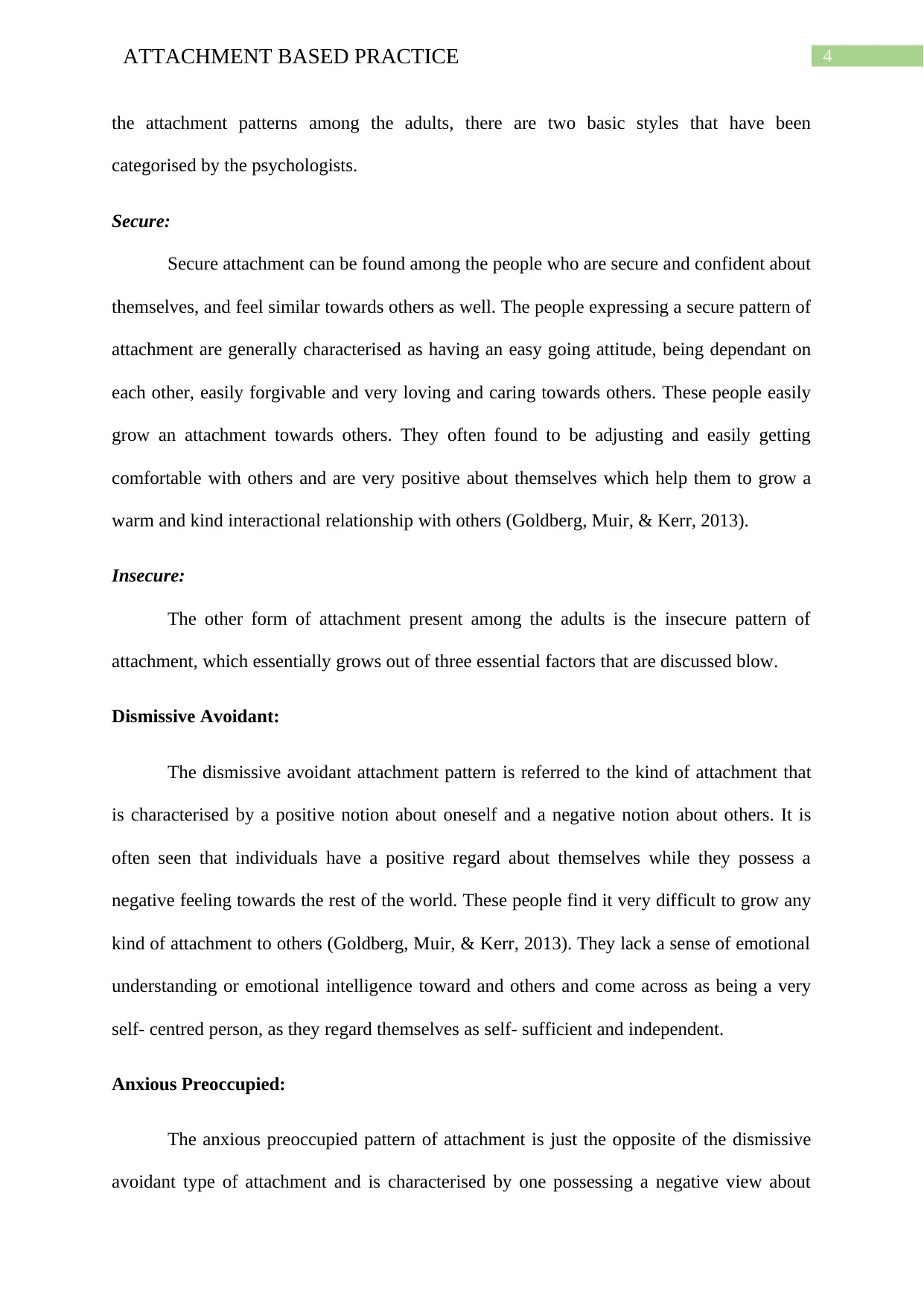
4ATTACHMENT BASED PRACTICE
the attachment patterns among the adults, there are two basic styles that have been
categorised by the psychologists.
Secure:
Secure attachment can be found among the people who are secure and confident about
themselves, and feel similar towards others as well. The people expressing a secure pattern of
attachment are generally characterised as having an easy going attitude, being dependant on
each other, easily forgivable and very loving and caring towards others. These people easily
grow an attachment towards others. They often found to be adjusting and easily getting
comfortable with others and are very positive about themselves which help them to grow a
warm and kind interactional relationship with others (Goldberg, Muir, & Kerr, 2013).
Insecure:
The other form of attachment present among the adults is the insecure pattern of
attachment, which essentially grows out of three essential factors that are discussed blow.
Dismissive Avoidant:
The dismissive avoidant attachment pattern is referred to the kind of attachment that
is characterised by a positive notion about oneself and a negative notion about others. It is
often seen that individuals have a positive regard about themselves while they possess a
negative feeling towards the rest of the world. These people find it very difficult to grow any
kind of attachment to others (Goldberg, Muir, & Kerr, 2013). They lack a sense of emotional
understanding or emotional intelligence toward and others and come across as being a very
self- centred person, as they regard themselves as self- sufficient and independent.
Anxious Preoccupied:
The anxious preoccupied pattern of attachment is just the opposite of the dismissive
avoidant type of attachment and is characterised by one possessing a negative view about
the attachment patterns among the adults, there are two basic styles that have been
categorised by the psychologists.
Secure:
Secure attachment can be found among the people who are secure and confident about
themselves, and feel similar towards others as well. The people expressing a secure pattern of
attachment are generally characterised as having an easy going attitude, being dependant on
each other, easily forgivable and very loving and caring towards others. These people easily
grow an attachment towards others. They often found to be adjusting and easily getting
comfortable with others and are very positive about themselves which help them to grow a
warm and kind interactional relationship with others (Goldberg, Muir, & Kerr, 2013).
Insecure:
The other form of attachment present among the adults is the insecure pattern of
attachment, which essentially grows out of three essential factors that are discussed blow.
Dismissive Avoidant:
The dismissive avoidant attachment pattern is referred to the kind of attachment that
is characterised by a positive notion about oneself and a negative notion about others. It is
often seen that individuals have a positive regard about themselves while they possess a
negative feeling towards the rest of the world. These people find it very difficult to grow any
kind of attachment to others (Goldberg, Muir, & Kerr, 2013). They lack a sense of emotional
understanding or emotional intelligence toward and others and come across as being a very
self- centred person, as they regard themselves as self- sufficient and independent.
Anxious Preoccupied:
The anxious preoccupied pattern of attachment is just the opposite of the dismissive
avoidant type of attachment and is characterised by one possessing a negative view about
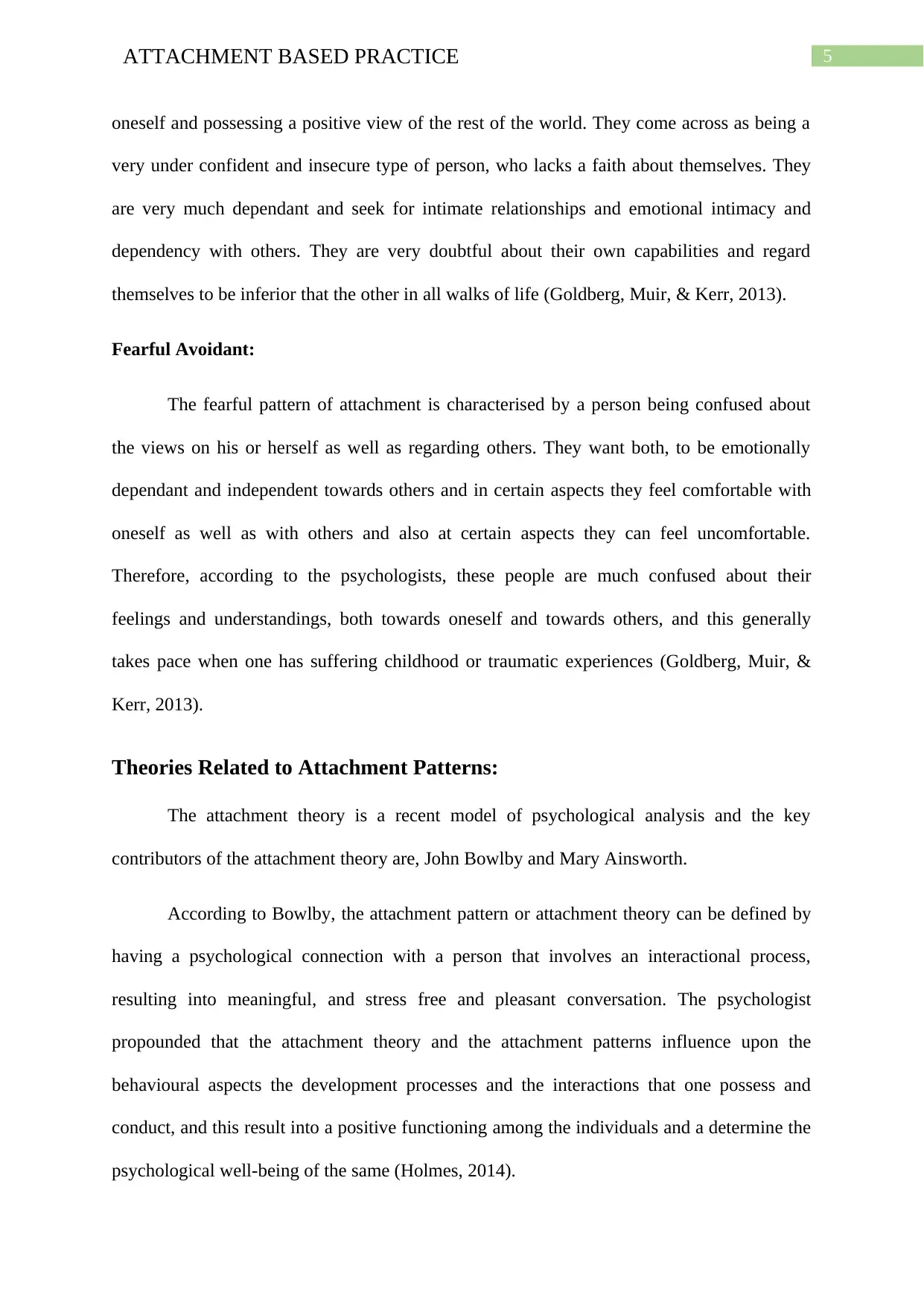
5ATTACHMENT BASED PRACTICE
oneself and possessing a positive view of the rest of the world. They come across as being a
very under confident and insecure type of person, who lacks a faith about themselves. They
are very much dependant and seek for intimate relationships and emotional intimacy and
dependency with others. They are very doubtful about their own capabilities and regard
themselves to be inferior that the other in all walks of life (Goldberg, Muir, & Kerr, 2013).
Fearful Avoidant:
The fearful pattern of attachment is characterised by a person being confused about
the views on his or herself as well as regarding others. They want both, to be emotionally
dependant and independent towards others and in certain aspects they feel comfortable with
oneself as well as with others and also at certain aspects they can feel uncomfortable.
Therefore, according to the psychologists, these people are much confused about their
feelings and understandings, both towards oneself and towards others, and this generally
takes pace when one has suffering childhood or traumatic experiences (Goldberg, Muir, &
Kerr, 2013).
Theories Related to Attachment Patterns:
The attachment theory is a recent model of psychological analysis and the key
contributors of the attachment theory are, John Bowlby and Mary Ainsworth.
According to Bowlby, the attachment pattern or attachment theory can be defined by
having a psychological connection with a person that involves an interactional process,
resulting into meaningful, and stress free and pleasant conversation. The psychologist
propounded that the attachment theory and the attachment patterns influence upon the
behavioural aspects the development processes and the interactions that one possess and
conduct, and this result into a positive functioning among the individuals and a determine the
psychological well-being of the same (Holmes, 2014).
oneself and possessing a positive view of the rest of the world. They come across as being a
very under confident and insecure type of person, who lacks a faith about themselves. They
are very much dependant and seek for intimate relationships and emotional intimacy and
dependency with others. They are very doubtful about their own capabilities and regard
themselves to be inferior that the other in all walks of life (Goldberg, Muir, & Kerr, 2013).
Fearful Avoidant:
The fearful pattern of attachment is characterised by a person being confused about
the views on his or herself as well as regarding others. They want both, to be emotionally
dependant and independent towards others and in certain aspects they feel comfortable with
oneself as well as with others and also at certain aspects they can feel uncomfortable.
Therefore, according to the psychologists, these people are much confused about their
feelings and understandings, both towards oneself and towards others, and this generally
takes pace when one has suffering childhood or traumatic experiences (Goldberg, Muir, &
Kerr, 2013).
Theories Related to Attachment Patterns:
The attachment theory is a recent model of psychological analysis and the key
contributors of the attachment theory are, John Bowlby and Mary Ainsworth.
According to Bowlby, the attachment pattern or attachment theory can be defined by
having a psychological connection with a person that involves an interactional process,
resulting into meaningful, and stress free and pleasant conversation. The psychologist
propounded that the attachment theory and the attachment patterns influence upon the
behavioural aspects the development processes and the interactions that one possess and
conduct, and this result into a positive functioning among the individuals and a determine the
psychological well-being of the same (Holmes, 2014).
⊘ This is a preview!⊘
Do you want full access?
Subscribe today to unlock all pages.

Trusted by 1+ million students worldwide
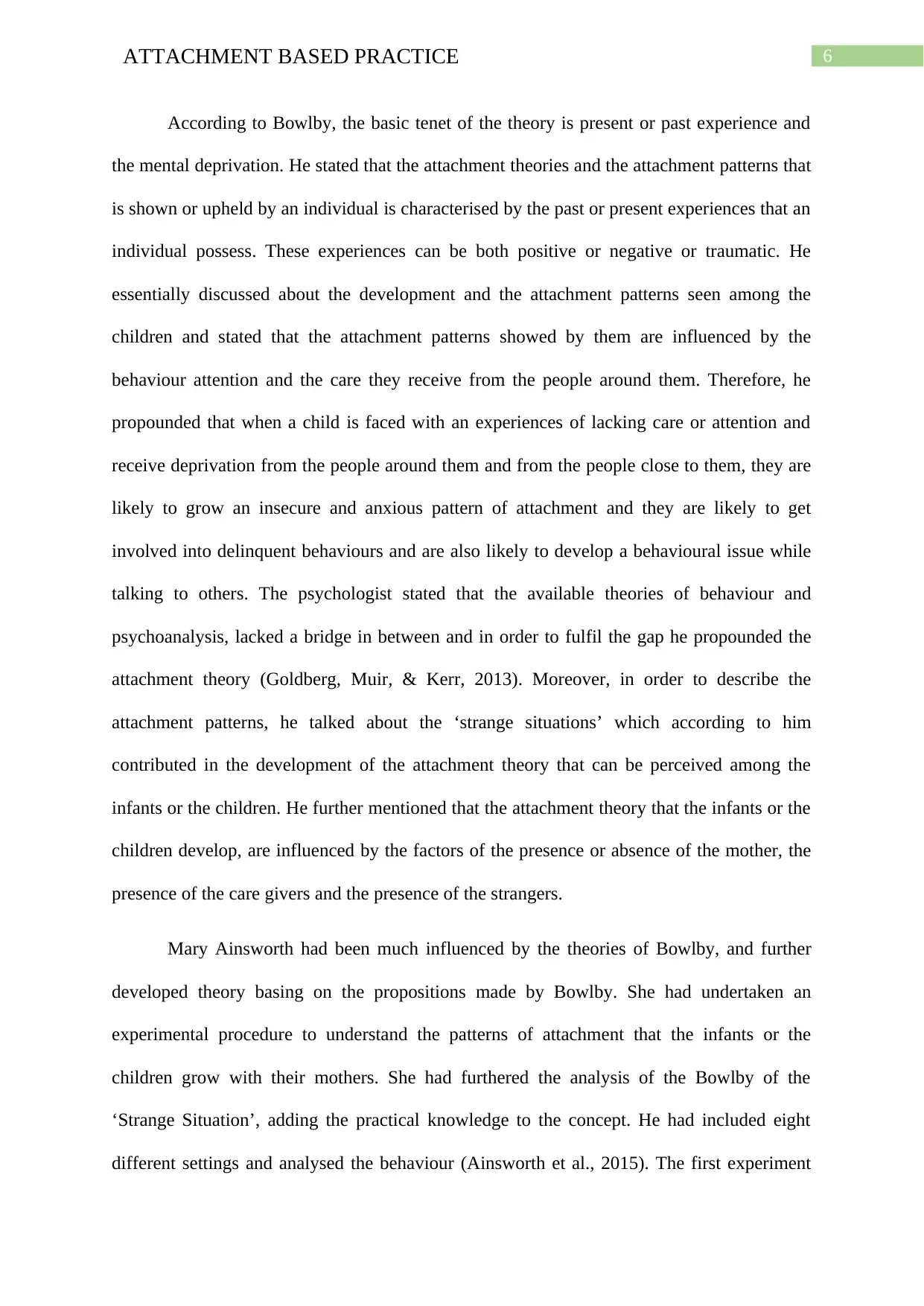
6ATTACHMENT BASED PRACTICE
According to Bowlby, the basic tenet of the theory is present or past experience and
the mental deprivation. He stated that the attachment theories and the attachment patterns that
is shown or upheld by an individual is characterised by the past or present experiences that an
individual possess. These experiences can be both positive or negative or traumatic. He
essentially discussed about the development and the attachment patterns seen among the
children and stated that the attachment patterns showed by them are influenced by the
behaviour attention and the care they receive from the people around them. Therefore, he
propounded that when a child is faced with an experiences of lacking care or attention and
receive deprivation from the people around them and from the people close to them, they are
likely to grow an insecure and anxious pattern of attachment and they are likely to get
involved into delinquent behaviours and are also likely to develop a behavioural issue while
talking to others. The psychologist stated that the available theories of behaviour and
psychoanalysis, lacked a bridge in between and in order to fulfil the gap he propounded the
attachment theory (Goldberg, Muir, & Kerr, 2013). Moreover, in order to describe the
attachment patterns, he talked about the ‘strange situations’ which according to him
contributed in the development of the attachment theory that can be perceived among the
infants or the children. He further mentioned that the attachment theory that the infants or the
children develop, are influenced by the factors of the presence or absence of the mother, the
presence of the care givers and the presence of the strangers.
Mary Ainsworth had been much influenced by the theories of Bowlby, and further
developed theory basing on the propositions made by Bowlby. She had undertaken an
experimental procedure to understand the patterns of attachment that the infants or the
children grow with their mothers. She had furthered the analysis of the Bowlby of the
‘Strange Situation’, adding the practical knowledge to the concept. He had included eight
different settings and analysed the behaviour (Ainsworth et al., 2015). The first experiment
According to Bowlby, the basic tenet of the theory is present or past experience and
the mental deprivation. He stated that the attachment theories and the attachment patterns that
is shown or upheld by an individual is characterised by the past or present experiences that an
individual possess. These experiences can be both positive or negative or traumatic. He
essentially discussed about the development and the attachment patterns seen among the
children and stated that the attachment patterns showed by them are influenced by the
behaviour attention and the care they receive from the people around them. Therefore, he
propounded that when a child is faced with an experiences of lacking care or attention and
receive deprivation from the people around them and from the people close to them, they are
likely to grow an insecure and anxious pattern of attachment and they are likely to get
involved into delinquent behaviours and are also likely to develop a behavioural issue while
talking to others. The psychologist stated that the available theories of behaviour and
psychoanalysis, lacked a bridge in between and in order to fulfil the gap he propounded the
attachment theory (Goldberg, Muir, & Kerr, 2013). Moreover, in order to describe the
attachment patterns, he talked about the ‘strange situations’ which according to him
contributed in the development of the attachment theory that can be perceived among the
infants or the children. He further mentioned that the attachment theory that the infants or the
children develop, are influenced by the factors of the presence or absence of the mother, the
presence of the care givers and the presence of the strangers.
Mary Ainsworth had been much influenced by the theories of Bowlby, and further
developed theory basing on the propositions made by Bowlby. She had undertaken an
experimental procedure to understand the patterns of attachment that the infants or the
children grow with their mothers. She had furthered the analysis of the Bowlby of the
‘Strange Situation’, adding the practical knowledge to the concept. He had included eight
different settings and analysed the behaviour (Ainsworth et al., 2015). The first experiment
Paraphrase This Document
Need a fresh take? Get an instant paraphrase of this document with our AI Paraphraser
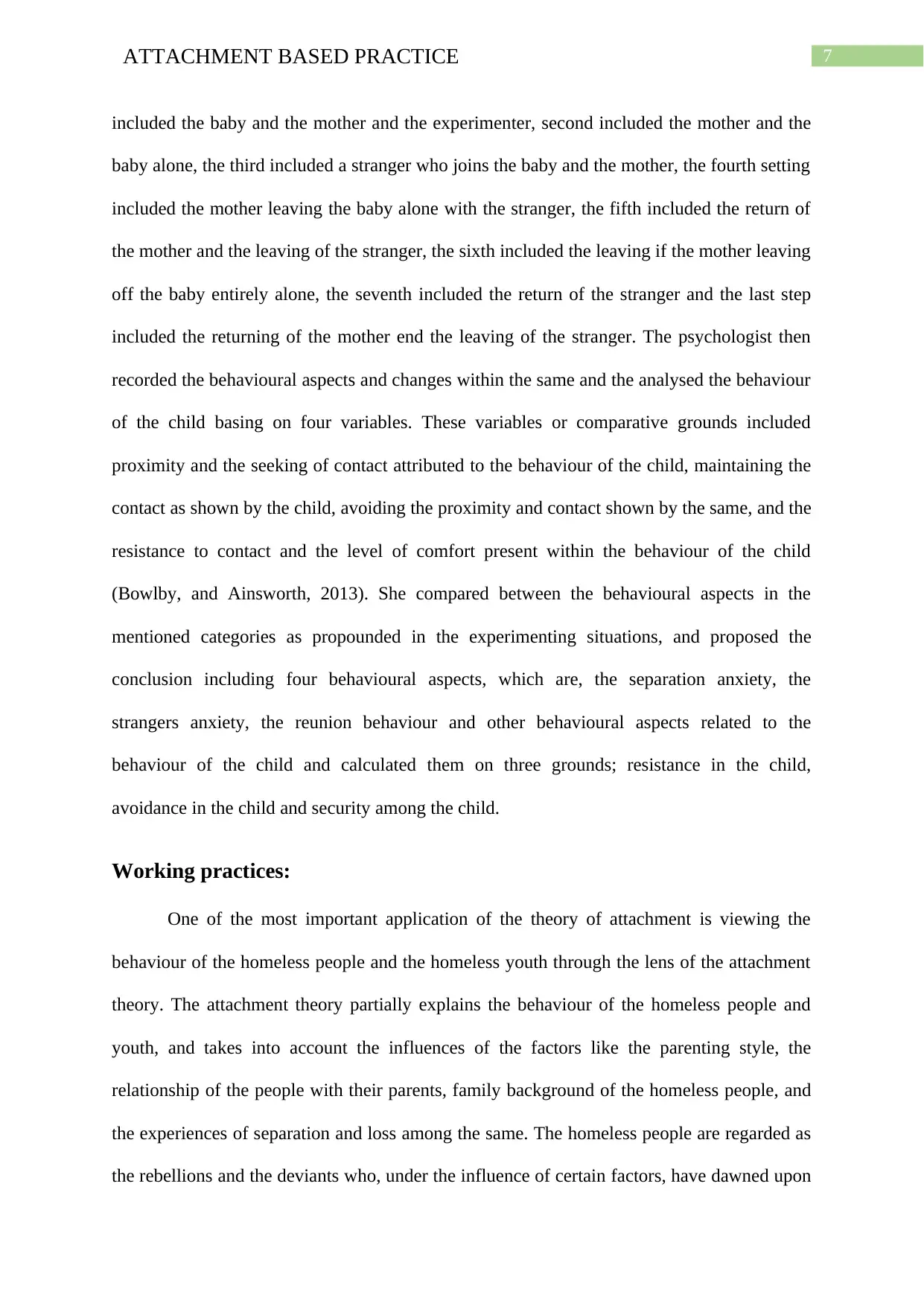
7ATTACHMENT BASED PRACTICE
included the baby and the mother and the experimenter, second included the mother and the
baby alone, the third included a stranger who joins the baby and the mother, the fourth setting
included the mother leaving the baby alone with the stranger, the fifth included the return of
the mother and the leaving of the stranger, the sixth included the leaving if the mother leaving
off the baby entirely alone, the seventh included the return of the stranger and the last step
included the returning of the mother end the leaving of the stranger. The psychologist then
recorded the behavioural aspects and changes within the same and the analysed the behaviour
of the child basing on four variables. These variables or comparative grounds included
proximity and the seeking of contact attributed to the behaviour of the child, maintaining the
contact as shown by the child, avoiding the proximity and contact shown by the same, and the
resistance to contact and the level of comfort present within the behaviour of the child
(Bowlby, and Ainsworth, 2013). She compared between the behavioural aspects in the
mentioned categories as propounded in the experimenting situations, and proposed the
conclusion including four behavioural aspects, which are, the separation anxiety, the
strangers anxiety, the reunion behaviour and other behavioural aspects related to the
behaviour of the child and calculated them on three grounds; resistance in the child,
avoidance in the child and security among the child.
Working practices:
One of the most important application of the theory of attachment is viewing the
behaviour of the homeless people and the homeless youth through the lens of the attachment
theory. The attachment theory partially explains the behaviour of the homeless people and
youth, and takes into account the influences of the factors like the parenting style, the
relationship of the people with their parents, family background of the homeless people, and
the experiences of separation and loss among the same. The homeless people are regarded as
the rebellions and the deviants who, under the influence of certain factors, have dawned upon
included the baby and the mother and the experimenter, second included the mother and the
baby alone, the third included a stranger who joins the baby and the mother, the fourth setting
included the mother leaving the baby alone with the stranger, the fifth included the return of
the mother and the leaving of the stranger, the sixth included the leaving if the mother leaving
off the baby entirely alone, the seventh included the return of the stranger and the last step
included the returning of the mother end the leaving of the stranger. The psychologist then
recorded the behavioural aspects and changes within the same and the analysed the behaviour
of the child basing on four variables. These variables or comparative grounds included
proximity and the seeking of contact attributed to the behaviour of the child, maintaining the
contact as shown by the child, avoiding the proximity and contact shown by the same, and the
resistance to contact and the level of comfort present within the behaviour of the child
(Bowlby, and Ainsworth, 2013). She compared between the behavioural aspects in the
mentioned categories as propounded in the experimenting situations, and proposed the
conclusion including four behavioural aspects, which are, the separation anxiety, the
strangers anxiety, the reunion behaviour and other behavioural aspects related to the
behaviour of the child and calculated them on three grounds; resistance in the child,
avoidance in the child and security among the child.
Working practices:
One of the most important application of the theory of attachment is viewing the
behaviour of the homeless people and the homeless youth through the lens of the attachment
theory. The attachment theory partially explains the behaviour of the homeless people and
youth, and takes into account the influences of the factors like the parenting style, the
relationship of the people with their parents, family background of the homeless people, and
the experiences of separation and loss among the same. The homeless people are regarded as
the rebellions and the deviants who, under the influence of certain factors, have dawned upon
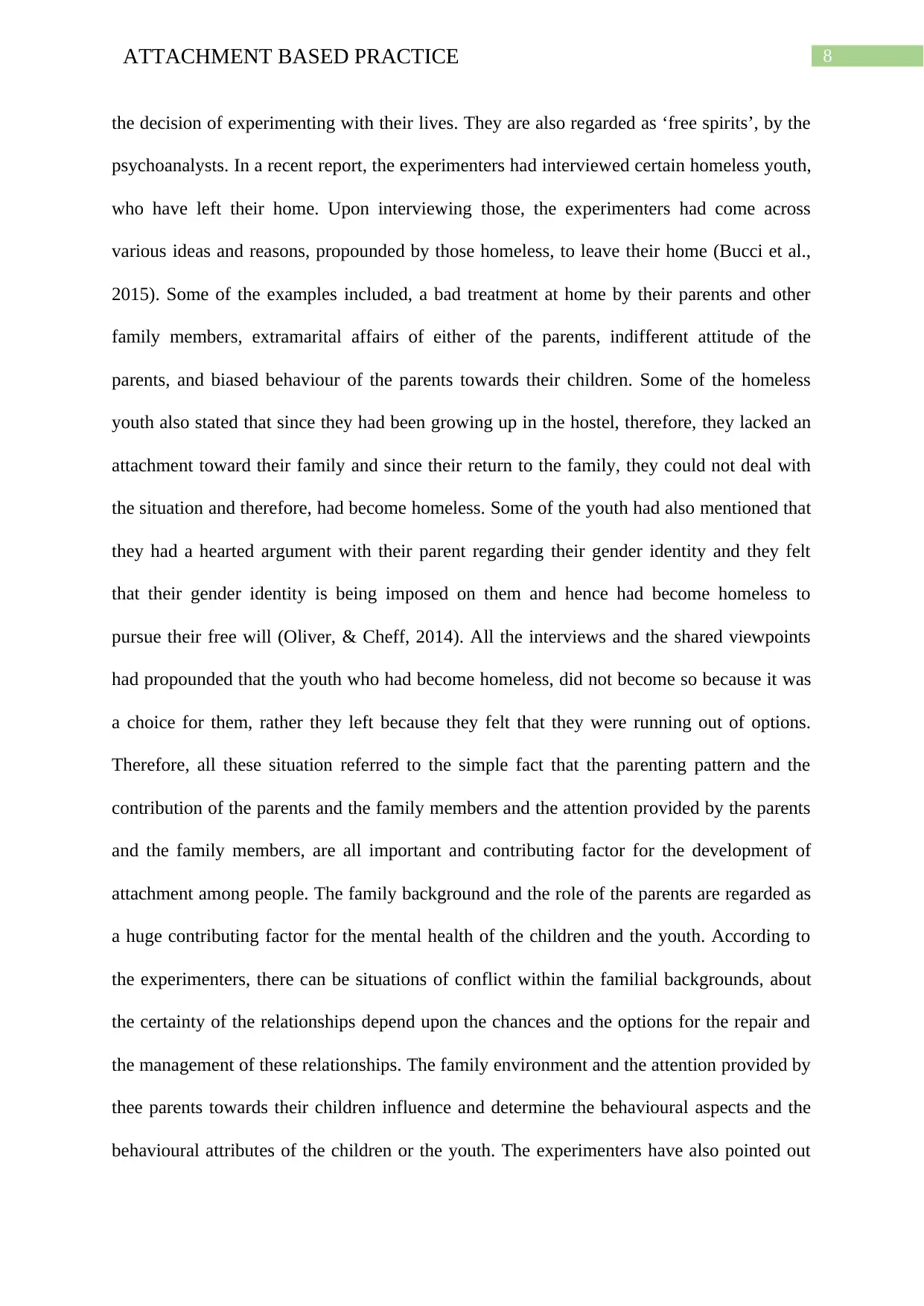
8ATTACHMENT BASED PRACTICE
the decision of experimenting with their lives. They are also regarded as ‘free spirits’, by the
psychoanalysts. In a recent report, the experimenters had interviewed certain homeless youth,
who have left their home. Upon interviewing those, the experimenters had come across
various ideas and reasons, propounded by those homeless, to leave their home (Bucci et al.,
2015). Some of the examples included, a bad treatment at home by their parents and other
family members, extramarital affairs of either of the parents, indifferent attitude of the
parents, and biased behaviour of the parents towards their children. Some of the homeless
youth also stated that since they had been growing up in the hostel, therefore, they lacked an
attachment toward their family and since their return to the family, they could not deal with
the situation and therefore, had become homeless. Some of the youth had also mentioned that
they had a hearted argument with their parent regarding their gender identity and they felt
that their gender identity is being imposed on them and hence had become homeless to
pursue their free will (Oliver, & Cheff, 2014). All the interviews and the shared viewpoints
had propounded that the youth who had become homeless, did not become so because it was
a choice for them, rather they left because they felt that they were running out of options.
Therefore, all these situation referred to the simple fact that the parenting pattern and the
contribution of the parents and the family members and the attention provided by the parents
and the family members, are all important and contributing factor for the development of
attachment among people. The family background and the role of the parents are regarded as
a huge contributing factor for the mental health of the children and the youth. According to
the experimenters, there can be situations of conflict within the familial backgrounds, about
the certainty of the relationships depend upon the chances and the options for the repair and
the management of these relationships. The family environment and the attention provided by
thee parents towards their children influence and determine the behavioural aspects and the
behavioural attributes of the children or the youth. The experimenters have also pointed out
the decision of experimenting with their lives. They are also regarded as ‘free spirits’, by the
psychoanalysts. In a recent report, the experimenters had interviewed certain homeless youth,
who have left their home. Upon interviewing those, the experimenters had come across
various ideas and reasons, propounded by those homeless, to leave their home (Bucci et al.,
2015). Some of the examples included, a bad treatment at home by their parents and other
family members, extramarital affairs of either of the parents, indifferent attitude of the
parents, and biased behaviour of the parents towards their children. Some of the homeless
youth also stated that since they had been growing up in the hostel, therefore, they lacked an
attachment toward their family and since their return to the family, they could not deal with
the situation and therefore, had become homeless. Some of the youth had also mentioned that
they had a hearted argument with their parent regarding their gender identity and they felt
that their gender identity is being imposed on them and hence had become homeless to
pursue their free will (Oliver, & Cheff, 2014). All the interviews and the shared viewpoints
had propounded that the youth who had become homeless, did not become so because it was
a choice for them, rather they left because they felt that they were running out of options.
Therefore, all these situation referred to the simple fact that the parenting pattern and the
contribution of the parents and the family members and the attention provided by the parents
and the family members, are all important and contributing factor for the development of
attachment among people. The family background and the role of the parents are regarded as
a huge contributing factor for the mental health of the children and the youth. According to
the experimenters, there can be situations of conflict within the familial backgrounds, about
the certainty of the relationships depend upon the chances and the options for the repair and
the management of these relationships. The family environment and the attention provided by
thee parents towards their children influence and determine the behavioural aspects and the
behavioural attributes of the children or the youth. The experimenters have also pointed out
⊘ This is a preview!⊘
Do you want full access?
Subscribe today to unlock all pages.

Trusted by 1+ million students worldwide
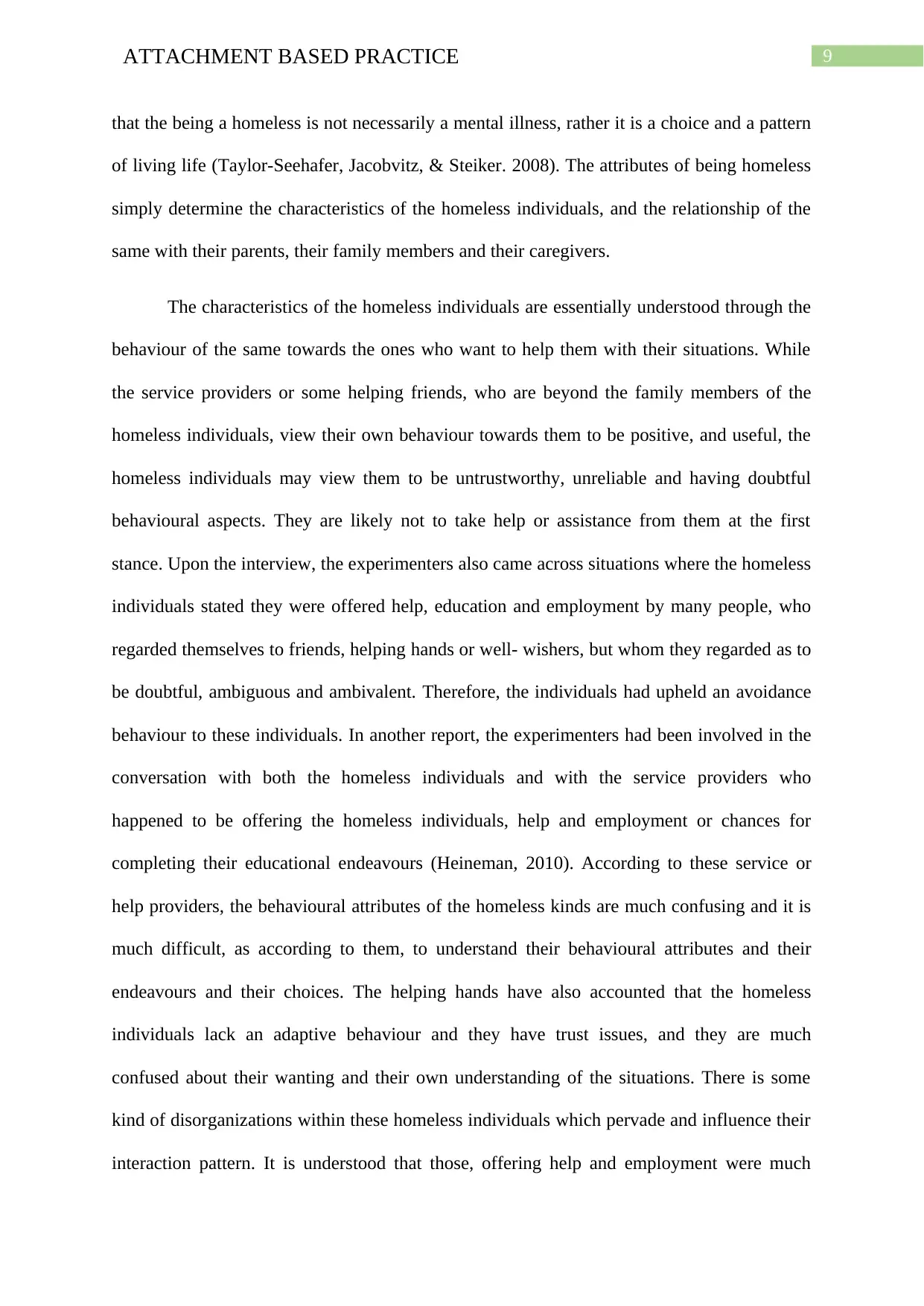
9ATTACHMENT BASED PRACTICE
that the being a homeless is not necessarily a mental illness, rather it is a choice and a pattern
of living life (Taylor-Seehafer, Jacobvitz, & Steiker. 2008). The attributes of being homeless
simply determine the characteristics of the homeless individuals, and the relationship of the
same with their parents, their family members and their caregivers.
The characteristics of the homeless individuals are essentially understood through the
behaviour of the same towards the ones who want to help them with their situations. While
the service providers or some helping friends, who are beyond the family members of the
homeless individuals, view their own behaviour towards them to be positive, and useful, the
homeless individuals may view them to be untrustworthy, unreliable and having doubtful
behavioural aspects. They are likely not to take help or assistance from them at the first
stance. Upon the interview, the experimenters also came across situations where the homeless
individuals stated they were offered help, education and employment by many people, who
regarded themselves to friends, helping hands or well- wishers, but whom they regarded as to
be doubtful, ambiguous and ambivalent. Therefore, the individuals had upheld an avoidance
behaviour to these individuals. In another report, the experimenters had been involved in the
conversation with both the homeless individuals and with the service providers who
happened to be offering the homeless individuals, help and employment or chances for
completing their educational endeavours (Heineman, 2010). According to these service or
help providers, the behavioural attributes of the homeless kinds are much confusing and it is
much difficult, as according to them, to understand their behavioural attributes and their
endeavours and their choices. The helping hands have also accounted that the homeless
individuals lack an adaptive behaviour and they have trust issues, and they are much
confused about their wanting and their own understanding of the situations. There is some
kind of disorganizations within these homeless individuals which pervade and influence their
interaction pattern. It is understood that those, offering help and employment were much
that the being a homeless is not necessarily a mental illness, rather it is a choice and a pattern
of living life (Taylor-Seehafer, Jacobvitz, & Steiker. 2008). The attributes of being homeless
simply determine the characteristics of the homeless individuals, and the relationship of the
same with their parents, their family members and their caregivers.
The characteristics of the homeless individuals are essentially understood through the
behaviour of the same towards the ones who want to help them with their situations. While
the service providers or some helping friends, who are beyond the family members of the
homeless individuals, view their own behaviour towards them to be positive, and useful, the
homeless individuals may view them to be untrustworthy, unreliable and having doubtful
behavioural aspects. They are likely not to take help or assistance from them at the first
stance. Upon the interview, the experimenters also came across situations where the homeless
individuals stated they were offered help, education and employment by many people, who
regarded themselves to friends, helping hands or well- wishers, but whom they regarded as to
be doubtful, ambiguous and ambivalent. Therefore, the individuals had upheld an avoidance
behaviour to these individuals. In another report, the experimenters had been involved in the
conversation with both the homeless individuals and with the service providers who
happened to be offering the homeless individuals, help and employment or chances for
completing their educational endeavours (Heineman, 2010). According to these service or
help providers, the behavioural attributes of the homeless kinds are much confusing and it is
much difficult, as according to them, to understand their behavioural attributes and their
endeavours and their choices. The helping hands have also accounted that the homeless
individuals lack an adaptive behaviour and they have trust issues, and they are much
confused about their wanting and their own understanding of the situations. There is some
kind of disorganizations within these homeless individuals which pervade and influence their
interaction pattern. It is understood that those, offering help and employment were much
Paraphrase This Document
Need a fresh take? Get an instant paraphrase of this document with our AI Paraphraser
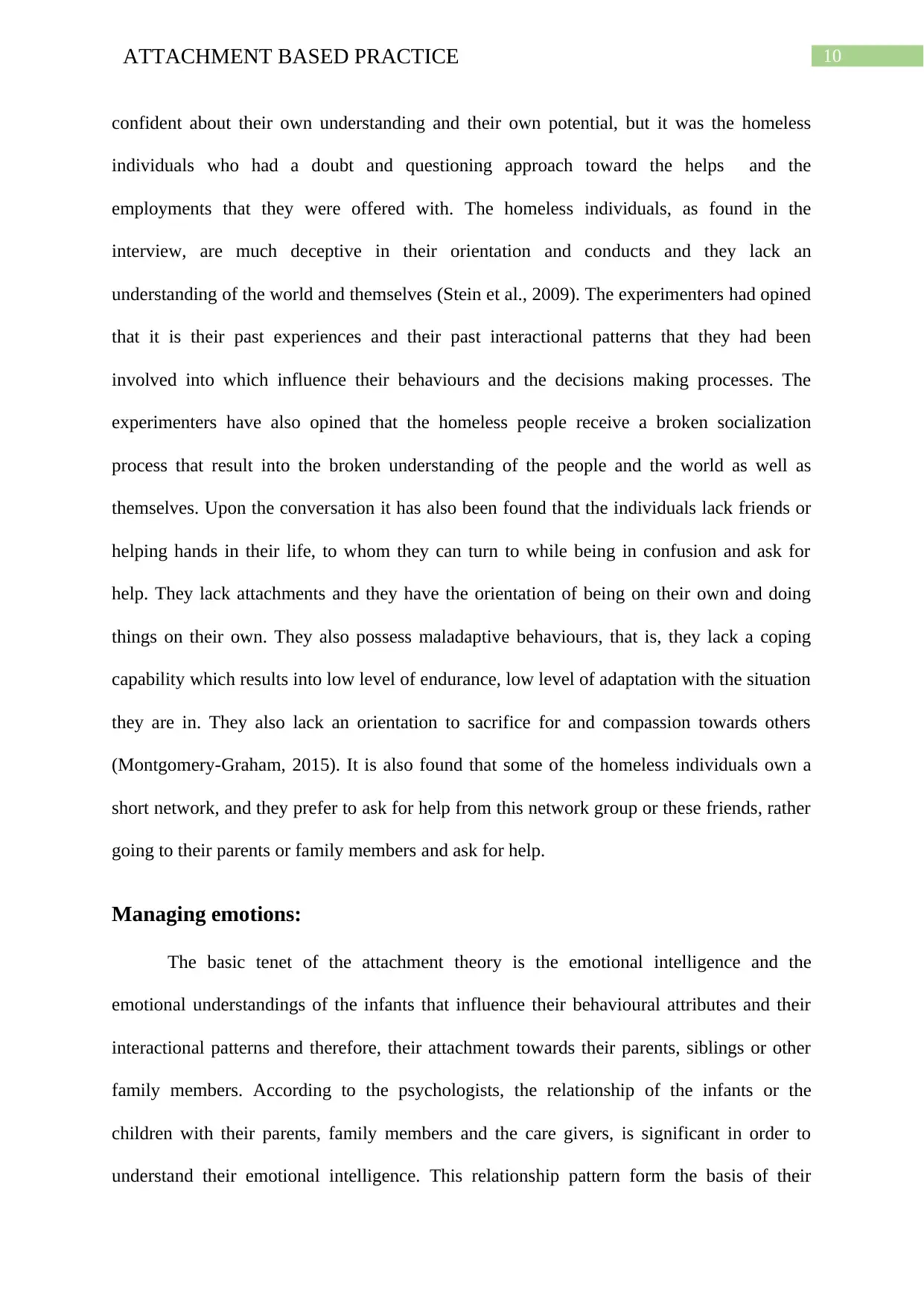
10ATTACHMENT BASED PRACTICE
confident about their own understanding and their own potential, but it was the homeless
individuals who had a doubt and questioning approach toward the helps and the
employments that they were offered with. The homeless individuals, as found in the
interview, are much deceptive in their orientation and conducts and they lack an
understanding of the world and themselves (Stein et al., 2009). The experimenters had opined
that it is their past experiences and their past interactional patterns that they had been
involved into which influence their behaviours and the decisions making processes. The
experimenters have also opined that the homeless people receive a broken socialization
process that result into the broken understanding of the people and the world as well as
themselves. Upon the conversation it has also been found that the individuals lack friends or
helping hands in their life, to whom they can turn to while being in confusion and ask for
help. They lack attachments and they have the orientation of being on their own and doing
things on their own. They also possess maladaptive behaviours, that is, they lack a coping
capability which results into low level of endurance, low level of adaptation with the situation
they are in. They also lack an orientation to sacrifice for and compassion towards others
(Montgomery-Graham, 2015). It is also found that some of the homeless individuals own a
short network, and they prefer to ask for help from this network group or these friends, rather
going to their parents or family members and ask for help.
Managing emotions:
The basic tenet of the attachment theory is the emotional intelligence and the
emotional understandings of the infants that influence their behavioural attributes and their
interactional patterns and therefore, their attachment towards their parents, siblings or other
family members. According to the psychologists, the relationship of the infants or the
children with their parents, family members and the care givers, is significant in order to
understand their emotional intelligence. This relationship pattern form the basis of their
confident about their own understanding and their own potential, but it was the homeless
individuals who had a doubt and questioning approach toward the helps and the
employments that they were offered with. The homeless individuals, as found in the
interview, are much deceptive in their orientation and conducts and they lack an
understanding of the world and themselves (Stein et al., 2009). The experimenters had opined
that it is their past experiences and their past interactional patterns that they had been
involved into which influence their behaviours and the decisions making processes. The
experimenters have also opined that the homeless people receive a broken socialization
process that result into the broken understanding of the people and the world as well as
themselves. Upon the conversation it has also been found that the individuals lack friends or
helping hands in their life, to whom they can turn to while being in confusion and ask for
help. They lack attachments and they have the orientation of being on their own and doing
things on their own. They also possess maladaptive behaviours, that is, they lack a coping
capability which results into low level of endurance, low level of adaptation with the situation
they are in. They also lack an orientation to sacrifice for and compassion towards others
(Montgomery-Graham, 2015). It is also found that some of the homeless individuals own a
short network, and they prefer to ask for help from this network group or these friends, rather
going to their parents or family members and ask for help.
Managing emotions:
The basic tenet of the attachment theory is the emotional intelligence and the
emotional understandings of the infants that influence their behavioural attributes and their
interactional patterns and therefore, their attachment towards their parents, siblings or other
family members. According to the psychologists, the relationship of the infants or the
children with their parents, family members and the care givers, is significant in order to
understand their emotional intelligence. This relationship pattern form the basis of their
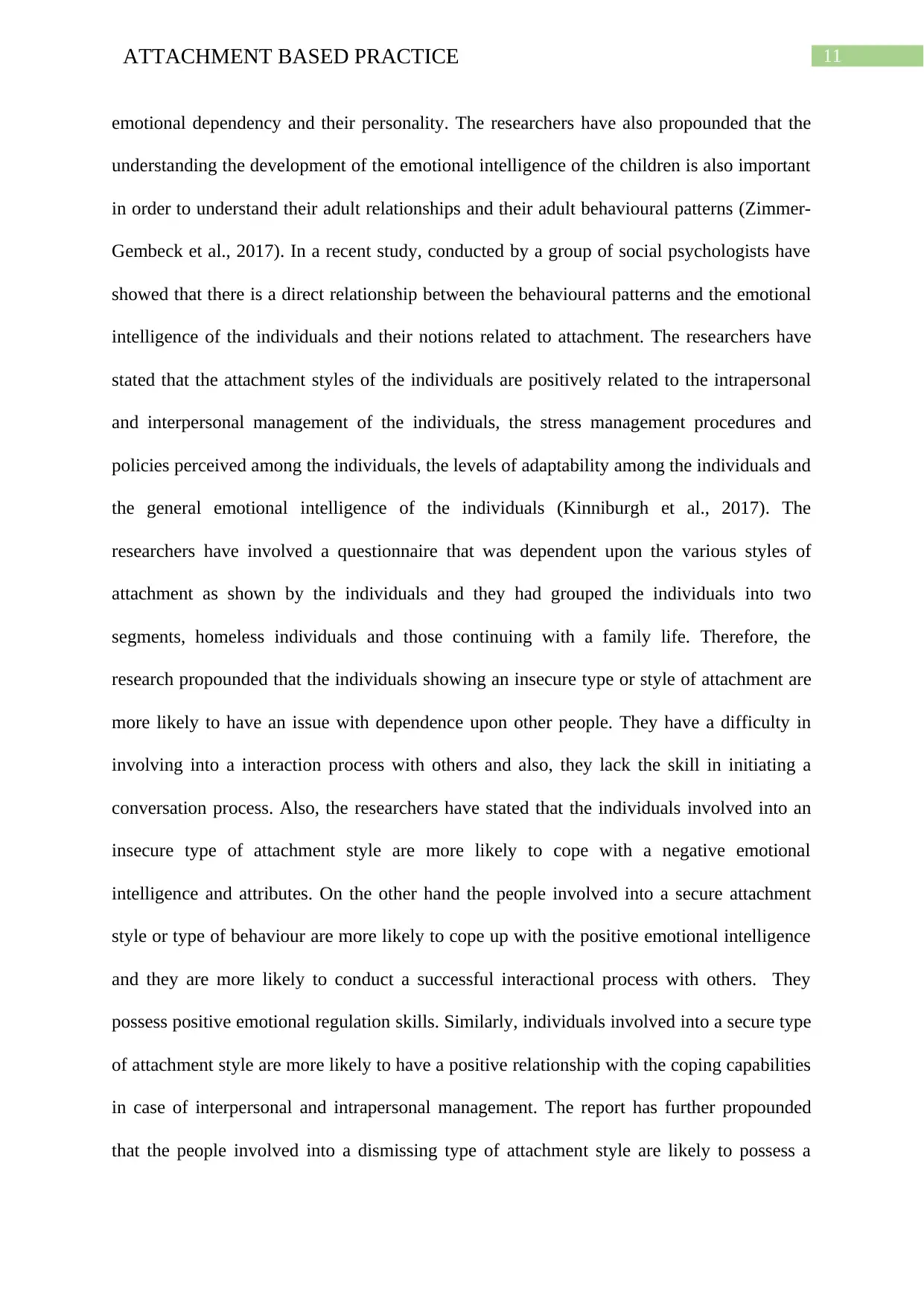
11ATTACHMENT BASED PRACTICE
emotional dependency and their personality. The researchers have also propounded that the
understanding the development of the emotional intelligence of the children is also important
in order to understand their adult relationships and their adult behavioural patterns (Zimmer-
Gembeck et al., 2017). In a recent study, conducted by a group of social psychologists have
showed that there is a direct relationship between the behavioural patterns and the emotional
intelligence of the individuals and their notions related to attachment. The researchers have
stated that the attachment styles of the individuals are positively related to the intrapersonal
and interpersonal management of the individuals, the stress management procedures and
policies perceived among the individuals, the levels of adaptability among the individuals and
the general emotional intelligence of the individuals (Kinniburgh et al., 2017). The
researchers have involved a questionnaire that was dependent upon the various styles of
attachment as shown by the individuals and they had grouped the individuals into two
segments, homeless individuals and those continuing with a family life. Therefore, the
research propounded that the individuals showing an insecure type or style of attachment are
more likely to have an issue with dependence upon other people. They have a difficulty in
involving into a interaction process with others and also, they lack the skill in initiating a
conversation process. Also, the researchers have stated that the individuals involved into an
insecure type of attachment style are more likely to cope with a negative emotional
intelligence and attributes. On the other hand the people involved into a secure attachment
style or type of behaviour are more likely to cope up with the positive emotional intelligence
and they are more likely to conduct a successful interactional process with others. They
possess positive emotional regulation skills. Similarly, individuals involved into a secure type
of attachment style are more likely to have a positive relationship with the coping capabilities
in case of interpersonal and intrapersonal management. The report has further propounded
that the people involved into a dismissing type of attachment style are likely to possess a
emotional dependency and their personality. The researchers have also propounded that the
understanding the development of the emotional intelligence of the children is also important
in order to understand their adult relationships and their adult behavioural patterns (Zimmer-
Gembeck et al., 2017). In a recent study, conducted by a group of social psychologists have
showed that there is a direct relationship between the behavioural patterns and the emotional
intelligence of the individuals and their notions related to attachment. The researchers have
stated that the attachment styles of the individuals are positively related to the intrapersonal
and interpersonal management of the individuals, the stress management procedures and
policies perceived among the individuals, the levels of adaptability among the individuals and
the general emotional intelligence of the individuals (Kinniburgh et al., 2017). The
researchers have involved a questionnaire that was dependent upon the various styles of
attachment as shown by the individuals and they had grouped the individuals into two
segments, homeless individuals and those continuing with a family life. Therefore, the
research propounded that the individuals showing an insecure type or style of attachment are
more likely to have an issue with dependence upon other people. They have a difficulty in
involving into a interaction process with others and also, they lack the skill in initiating a
conversation process. Also, the researchers have stated that the individuals involved into an
insecure type of attachment style are more likely to cope with a negative emotional
intelligence and attributes. On the other hand the people involved into a secure attachment
style or type of behaviour are more likely to cope up with the positive emotional intelligence
and they are more likely to conduct a successful interactional process with others. They
possess positive emotional regulation skills. Similarly, individuals involved into a secure type
of attachment style are more likely to have a positive relationship with the coping capabilities
in case of interpersonal and intrapersonal management. The report has further propounded
that the people involved into a dismissing type of attachment style are likely to possess a
⊘ This is a preview!⊘
Do you want full access?
Subscribe today to unlock all pages.

Trusted by 1+ million students worldwide
1 out of 17
Related Documents
Your All-in-One AI-Powered Toolkit for Academic Success.
+13062052269
info@desklib.com
Available 24*7 on WhatsApp / Email
![[object Object]](/_next/static/media/star-bottom.7253800d.svg)
Unlock your academic potential
Copyright © 2020–2025 A2Z Services. All Rights Reserved. Developed and managed by ZUCOL.





